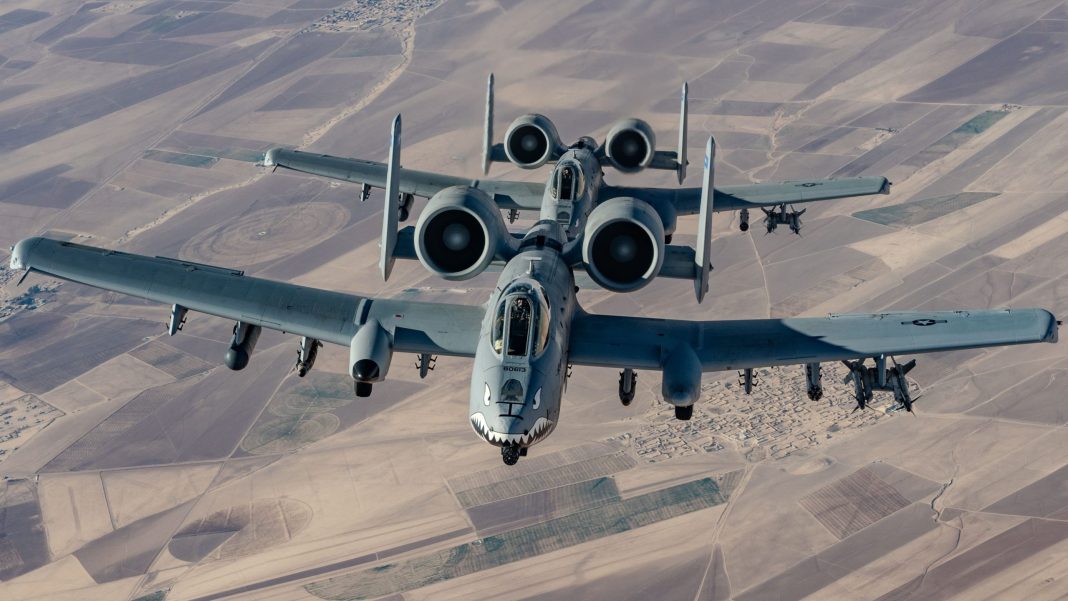Six A-10C jets of the U.S. Air National Guard have been stuck in Italy since November 2024, waiting for spare parts before the transoceanic flight that will take them back home.
Six A-10C Thunderbolt II attack jets of the U.S. Air National Guard have been stuck at Naval Air Station Sigonella, Italy, for two months, reported Stars and Stripes. According to an Air Force spokesperson, who spoke to the publication on background, the jets were left there due to unspecified maintenance issues.
Maintenance issues
The jets were on their way to return to the United States after completing their deployment in the Middle East in November 2024. The Warthogs were scheduled to make a stop-over at NAS Sigonella before continuing for Lajes Air Base, Portugal, from where they would have started their transoceanic flight.
The aircraft reportedly arrived there on Nov. 12, 2024, together with another six-ship flight. Of the 12 total A-10s, only half departed. Four of the remaining jets are assigned to the Maryland Air National Guard while the other two belong to the Michigan Air National Guard, according to the Air Force.

In an initial version of the story by Stars and Stripes, the spokesperson said that the wait was dependent on spare parts’ availability and the problem was expected to be solved in a couple of weeks. In an updated story, Maj. Benjamin Hughes, a spokesman for the Maryland National Guard, said that “the six A-10s are projected to depart on (Thursday).”
Hughes further mentioned that only five A-10s needed repairs, while the sixth was mission ready, proceeding to explain why they couldn’t cross the ocean. “Air Force regulations require all aircraft to be fully mission capable before scheduling a transoceanic fighter jet movement,” Hughes said. “The standard for a fighter jet movement is six aircraft.”
Deployments to the Middle East
While the U.S. Air Force is working to divest the entire A-10 fleet, the aircraft is still being employed both in the Middle East and the Pacific theater. Recently, the A-10s were part of multiple strikes against ISIS targets in Iraq, providing close air support to ground forces. These strikes followed the fall of the Syrian regime, in an effort to prevent the remaining militants to exploit the situation in the country to their advantage.
“Partnered operations like these are critical to maintaining pressure on ISIS and preventing the terrorist group from taking advantage of the rapidly changing security environment in the region,” CENTCOM commander Army Gen. Michael “Erik” Kurilla said in a statement earlier this month. “The enduring defeat of ISIS is a global effort that relies on our Coalition, allies, and partners. U.S. Central Command remains committed to aggressively pursuing these terrorists that threaten the region, our allies, and our citizens.”

The Warthogs recently saw action also over Syria. According to unconfirmed reports dated Dec. 1, 2024, around al-Mayadin, in the eastern part of the country, a key area linking Syria and Iraq, A-10s carried out intense strikes on militia targets, including bases, vehicles, and ammo depots.
Few days later, on Dec. 3, clips began circulating online showing Warthogs flying at low altitude, maneuvering, and releasing flares, reportedly over Deir Al Zor. The latest videos came a few weeks after other footage, once again allegedly filmed in Syria, was posted online showing U.S. Air Force A-10s at work against Iranian proxies in the northeastern part of the country.
The reason for the A-10 still being employed in the region is that it has a pretty permissive environment, without heavy air defenses. The jet has relatively low operational costs and loiter over the battlefield for extended periods, providing continuous support to troops on the ground.
Its slow speed and low-altitude flying capabilities allow for precise targeting and close coordination with friendly forces, minimizing the risk of collateral damage. These capabilities, together with its rugged design, powerful armament, and impressive maneuverability, allowed the A-10 to earn its reputation as one of the most iconic and effective CAS assets, designed specifically for the role of providing support to ground forces in combat situations.

The A-10’s retirement
While the retirement of the A-10 has been ongoing for some years, it now appears to have been accelerated. In fact, at least 39 A-10s were sent to the boneyard at Davis-Monthan Air Force Base, Arizona, during 2024, more than double the 17 reported in 2023. As of September 2024, 50 A-10As and 107 A-10Cs were stored at the facility.
The Air Force aims to completely retire the type by the end of the decade. In November 2024, the service also announced that in January 2025 it was planning to start the withdrawal of the 24 A-10Cs of the 25th Fighter Squadron at Osan Air Base, South Korea, with completion expected by the end of the fiscal year.
With the withdrawal of the type from the ranks of the 25th FS, the service would have left only the Warthogs based in the U.S. with both active duty and ANG units. However, some of the remaining aircraft might still get another lease of life abroad.
In fact, the Senate Committee on Armed Services has directed the Secretary of Defense, Lloyd Austin III, to explore the possibility of transferring retired A-10Cs to Jordan. The Committed put the requirement that the Secretary of Defense also assess Jordan’s ability to maintain the aircraft on their own.



